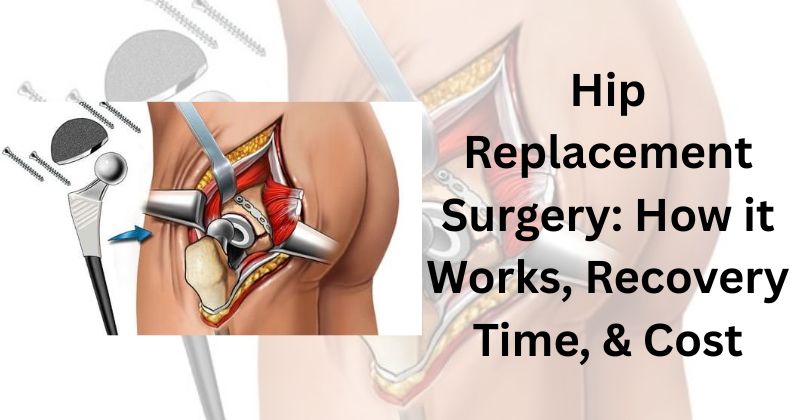
During hip replacement surgery, the distorted hip joint is replaced with an artificial rod or bone, or simply known as hip arthroplasty. The operation most commonly is needed where there is Severe pain or movement problem in the hip joint because of conditions like Arthritis, injury, or diseases. The hip joint is a ball at the end of the femur, or the thigh bone, and a socket in the pelvis, or hip bone. Hip replacement surgery is when both or either of these are replaced. Here in this blog, we discussed the hip replacement surgery costs and the costs of hip replacement surgery in India.
What are the different types of hip replacement surgery?
There are three major types of hip surgery:
- Total hip replacement: It is the most common type of hip replacement, in which the ball and socket of the hip joint are replaced by artificial ones.
- Partial hip replacement: Partial hip replacement involves the replacement of the ball of the femoral head of the hip joint, while the socket is preserved.
- Hip resurfacing:- Hip resurfacing involves replacing the surface of the femoral head with a metal cap of a smooth finish, while the socket is replaced with a metal cup.
How do you know if you need hip replacement surgery?
If the quality of life is being troubled by hip pain, it is time to go for a hip replacement surgery. The signs and symptoms of degradation of the quality of life are as follows:
- Can not sleep properly because of pain.
- Can not dress and climb stairs due to inability.
- Can not take part fully in your favorite hobbies.
Initially your doctor will offer other forms of treatments including pain or inflammation medication, walking devices, joint injections, and physiotherapy. Should they not ease the pain and stiffness, hip replacement surgery can be performed in a bid to improve function and overall quality of life.
What is the recovery time for a hip replacement?
Recovery will start within 24 hours after hip replacement surgery. Most of the patients having hip replacement start walking using a cane walker or crutches after one or two days of surgery. As time passes, you will walk further. Complete recovery usually takes two to eight weeks based on the overall health of the patient and other factors. As with every procedure, there is always risk of complications occurring during and following hip replacement ranging from infection of the incision site, fracture of the bone, to hip dislocation. If you feel fever, drainage from the wound site, stiffness of your hip, or unrelieved pain by your medication, call your doctor immediately.
What is the cost of hip replacement surgery in India?
Hip replacement surgery cost in India could be a determining reason for choosing this Process. The price of the surgery will differ depending on a range of reasons, some of which are the type of replacement surgery being performed, the city in which the surgery is occurring, the hospital center, the level of experience of the surgeon, and the choice of implant. For example, partial replacement hip surgery may range from Rs 1 lakh to Rs 1.5 lakh. Total hip replacement may range between Rs 2 lakh and Rs 3.5 lakh for a single side. The remaining procedures like hip resurfacing or hip revision may be case-to-case variable and depending on the amount of surgery.
The Surgical Process of Hip Replacement
Hip replacement surgery or total hip arthroplasty involves removal of the degenerated bone and cartilage in the hip joint and replacement with artificial components. Its objective is to eliminate pain and enhance function. The surgical process normally involves cutting, removal of the damaged femoral head, acetabular preparation (hip socket), placement of the new socket and femoral stem, and fixation of the new joint.
In-Depth Hip Replacement Surgical Process:
- Incision and anesthesia: General or local anesthesia is given to the patient for relaxation and comfort. The surgeon makes an incision into the hip joint, often in the side or back, to reach the hip. On the basis of the surgeon’s choice and patient requirement, the approach (anterior, posterior, or lateral) can be tailored.
- Debridement of the affected area: The affected femoral head (hip joint ball) is removed along with any patients or arthritic bone and cartilage of the acetabulum (hip socket).
- Bone preparation: Acetabulum is prepared by removal of the affected bone and resurfacing of the socket to accommodate the new acetabular component (new socket). Femoral canal (femoral inner cavity) is also prepared to accommodate the new femoral stem.
Conclusion
Hip replacement operation is one procedure that has been known to remarkably enhance the functional capacity of someone with bad pain and restriction of movement. After some time of recovery, some commitment to physiotherapy must be done but, as most patients discover, a lot can be attained concerning functional restoration. Although costly, the ultimate return of operation would generally overshadow expenses. Hip replacement surgery is a popular and successful operation that is employed to alleviate long-standing joint pain, most commonly due to arthritis or trauma. In surgery, the fractured hip joint is replaced with an artificial one composed of metal concrete or plastic.
For more(Click Here)




